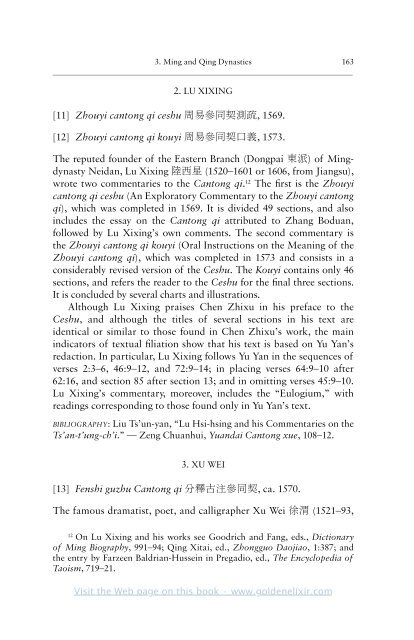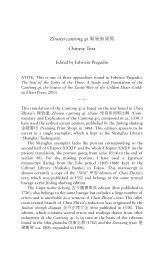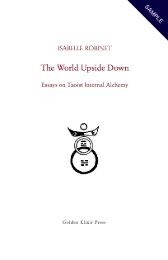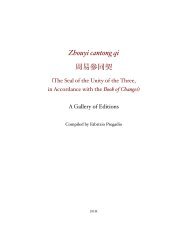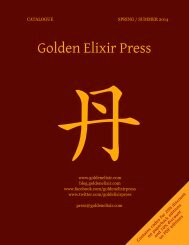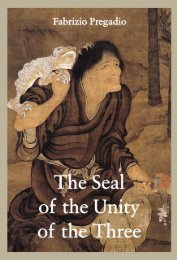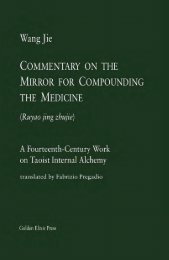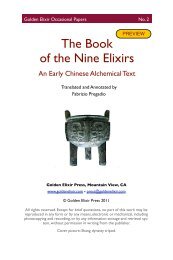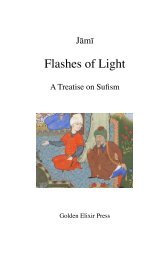The Seal of the Unity of the Three â Vol. 2 - The Golden Elixir
The Seal of the Unity of the Three â Vol. 2 - The Golden Elixir
The Seal of the Unity of the Three â Vol. 2 - The Golden Elixir
- No tags were found...
You also want an ePaper? Increase the reach of your titles
YUMPU automatically turns print PDFs into web optimized ePapers that Google loves.
3. Ming and Qing Dynasties 163<br />
—————————————————————————————————————————<br />
2. LU XIXING<br />
[11] Zhouyi cantong qi ceshu 周 易 參 同 契 測 疏 , 1569.<br />
[12] Zhouyi cantong qi kouyi 周 易 參 同 契 口 義 , 1573.<br />
<strong>The</strong> reputed founder <strong>of</strong> <strong>the</strong> Eastern Branch (Dongpai 東 派 ) <strong>of</strong> Mingdynasty<br />
Neidan, Lu Xixing 陸 西 星 (1520–1601 or 1606, from Jiangsu),<br />
wrote two commentaries to <strong>the</strong> Cantong qi. 12 <strong>The</strong> first is <strong>the</strong> Zhouyi<br />
cantong qi ceshu (An Exploratory Commentary to <strong>the</strong> Zhouyi cantong<br />
qi), which was completed in 1569. It is divided 49 sections, and also<br />
includes <strong>the</strong> essay on <strong>the</strong> Cantong qi attributed to Zhang Boduan,<br />
followed by Lu Xixing’s own comments. <strong>The</strong> second commentary is<br />
<strong>the</strong> Zhouyi cantong qi kouyi (Oral Instructions on <strong>the</strong> Meaning <strong>of</strong> <strong>the</strong><br />
Zhouyi cantong qi), which was completed in 1573 and consists in a<br />
considerably revised version <strong>of</strong> <strong>the</strong> Ceshu. <strong>The</strong> Kouyi contains only 46<br />
sections, and refers <strong>the</strong> reader to <strong>the</strong> Ceshu for <strong>the</strong> final three sections.<br />
It is concluded by several charts and illustrations.<br />
Although Lu Xixing praises Chen Zhixu in his preface to <strong>the</strong><br />
Ceshu, and although <strong>the</strong> titles <strong>of</strong> several sections in his text are<br />
identical or similar to those found in Chen Zhixu’s work, <strong>the</strong> main<br />
indicators <strong>of</strong> textual filiation show that his text is based on Yu Yan’s<br />
redaction. In particular, Lu Xixing follows Yu Yan in <strong>the</strong> sequences <strong>of</strong><br />
verses 2:3–6, 46:9–12, and 72:9–14; in placing verses 64:9–10 after<br />
62:16, and section 85 after section 13; and in omitting verses 45:9–10.<br />
Lu Xixing’s commentary, moreover, includes <strong>the</strong> “Eulogium,” with<br />
readings corresponding to those found only in Yu Yan’s text.<br />
BIBLIOGRAPHY: Liu Ts’un-yan, “Lu Hsi-hsing and his Commentaries on <strong>the</strong><br />
Ts’an-t’ung-ch’i.” — Zeng Chuanhui, Yuandai Cantong xue, 108–12.<br />
3. XU WEI<br />
[13] Fenshi guzhu Cantong qi 分 釋 古 注 參 同 契 , ca. 1570.<br />
<strong>The</strong> famous dramatist, poet, and calligrapher Xu Wei 徐 渭 (1521–93,<br />
12<br />
On Lu Xixing and his works see Goodrich and Fang, eds., Dictionary<br />
<strong>of</strong> Ming Biography, 991–94; Qing Xitai, ed., Zhongguo Daojiao, 1:387; and<br />
<strong>the</strong> entry by Farzeen Baldrian-Hussein in Pregadio, ed., <strong>The</strong> Encyclopedia <strong>of</strong><br />
Taoism, 719–21.<br />
Visit <strong>the</strong> Web page on this book • www.goldenelixir.com


